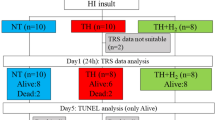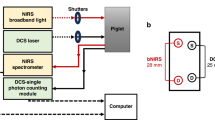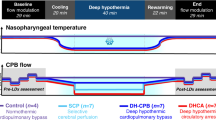Abstract
Near infrared spectroscopy (NIRS) shows large changes in cerebral oxyhemoglobin (Hbo2), deoxyhemoglobin (Hb), and oxidation state of cytochrome aa3 (Cyto2) in infants undergoing cardiopulmonary bypass and deep hypothermic circulatory arrest (CPB-DHCA). To evaluate the physiologic significance of these clinical NIRS measurements, we applied the technique in a piglet model of CPB-DHCA. After an initial stabilization period on CPB, animals (n = 8) were cooled to 15°C, subjected to DHCA for 1 h, then reperfused with rewarming and monitored for 180 min. NIRS measurements were compared with determinations of cerebral blood flow (CBF). During cooling, Cyto2 decreased markedly, whereas Hbo2 increased. DHCA was associated with a sharp decrease in Hbo2, a corresponding increase in Hb, and a smaller, less consistent further decrease in Cyto2. NIRS measurements recovered toward baseline with reperfusion. CBF decreased during cooling and recovered to baseline levels with reperfusion. These findings are consistent with existing human data and show that 1) cooling is associated with increased oxygenation of cerebral hemoglobin despite a reduction in CBF; 2) Cyto2 becomes more reduced during cooling, consistent with a net cellular oxygen deficit; and 3) DHCA is associated with rapid cerebral hemoglobin deoxygenation and a small further reduction of Cyto2.
Similar content being viewed by others
Log in or create a free account to read this content
Gain free access to this article, as well as selected content from this journal and more on nature.com
or
Abbreviations
- CPB:
-
cardiopulmonary bypass
- CA:
-
cardiac arrest
- DHCA:
-
deep hypothermic circulatory arrest
- CBF:
-
cerebral blood flow
- MAP:
-
mean arterial blood pressure
- NIRS:
-
near infrared spectroscopy
- dpf:
-
differential path length factor
- Hbo2:
-
oxygenated Hb
- Hb:
-
deoxygenated Hb
- HbT:
-
total Hb
- Cyto2:
-
oxidation state of cytochromeaa3
- MRS:
-
magnetic resonance spectroscopy
- PCr:
-
phosphocreatine
- pHi:
-
intracellular pH
References
Benson DW Jr 1989 Changing profile of congenital heart disease. Pediatrics 83: 790–791
Rappaport LA, Bellinger D, Wypij D 1996 Developmental findings at one year. In: Jonas RAJ, Newburger W, and Volpe JJ (eds) Brain Injury and Pediatric Cardiac Surgery. Butterworth-Heinemann, Boston, pp 341–352
Kuban KC, Wypij D 1996 Neurologic and MRI findings. In: Jonas RA, Newburger JW, and Volpe JJ (eds) Brain Injury and Pediatric Cardiac Surgery. Butterworth-Heinemann, Boston, pp 329–340
Newburger JW, Jonas RA, Wernovsky G, Wypij D, Hickey PR, Kuban KC, Farrell DM, Holmes GL, Helmers SL, Constantinou J, Carrazana E, Barlow JK, Walsh AZ, Lucius KC, Share JC, Wessel DL, Hanley FL, Mayer JE, Castaneda AR, Ware JH 1993 A comparison of the perioperative neurologic effects of hypothermic circulatory arrest versus low-flow cardiopulmonary bypass in infant heart surgery [see comments]. N Engl J Med 329: 1057–1064
Greeley WJ, Ungerleider RM, Kern FH, Brusino FG, Smith LR, Reves JG 1989 Effects of cardiopulmonary bypass on cerebral blood flow in neonates, infants, and children. Circulation 80: 1209:1215
Greeley WJ, Ungerleider RM, Smith LR, Reves JG 1989 The effects of deep hypothermic cardiopulmonary bypass and total circulatory arrest on cerebral blood flow in infants and children. J Thorac Cardiovasc Surg 97: 737–745
Kawata H, Fackler JC, Aoki M, Tsuji MK, Sawatari K, Offutt M, Hickey PR, Holtzman D, Jonas RA 1993 Recovery of cerebral blood flow and energy state in piglets after hypothermic circulatory arrest versus recovery after low-flow bypass. J Thorac Cardiovasc Surg 106: 671–685
Greeley WJ, Kern FH, Meliones JN, Ungerleider RM 1993 Effect of deep hypothermia and circulatory arrest on cerebral blood flow and metabolism. Ann Thorac Surg 56: 1464–1466
Jobsis FF 1977 Noninvasive, infrared monitoring of cerebral and myocardial oxygen sufficiency and circulatory parameters. Science 198: 1264–1267
Fallon P, Roberts I, Kirkham FJ, Elliott MJ, Lloyd-Thomas A, Maynard R, Edwards AD 1993 Cerebral hemodynamics during cardiopulmonary bypass in children using near-infrared spectroscopy. Ann Thorac Surg 56: 1473–1477
Fallon P, Roberts IG, Kirkham FJ, Edwards AD, Lloyd-Thomas A, Elliott MJ 1994 Cerebral blood volume response to changes in carbon dioxide tension before and during cardiopulmonary bypass in children, investigated by near infrared spectroscopy. Eur J Cardiothorac Surg 8: 130–134
Greeley WJ, Bracey VA, Ungerleider RM, Greibel JA, Kern FH, Boyd JL, Reves JG, Piantadosi CA 1991 Recovery of cerebral metabolism and mitochondrial oxidation state is delayed after hypothermic circulatory arrest. Circulation 84: III400–III46
Kurth CD, Steven JM, Nicolson SC, Chance B, Delivoria-Papadopoulos M 1992 Kinetics of cerebral deoxygenation during deep hypothermic circulatory arrest in neonates. Anesthesiology 77: 656–661
Kurth CD, Steven JM, Benaron D, Chance B 1993 Near-infrared monitoring of the cerebral circulation. J Clin Monit 9: 163–170
Kurth CD, Steven JM, Nicolson SC 1995 Cerebral oxygenation during pediatric cardiac surgery using deep hypothermic circulatory arrest. Anesthesiology 82: 74–82
Tamura M, Tamura T 1994 Non-invasive monitoring of brain oxygen sufficiency on cardiopulmonary bypass patients by near-infra-red laser spectrophotometry. Med Biol Eng Comput 32:S151–S156
du Plessis AJ, Newburger J, Jonas RA, Hickey P, Naruse H, Tsuji M, Walsh A, Walter G, Wypij D, Volpe JJ 1995 Cerebral oxygen supply and utilization during infant cardiac surgery. Ann Neurol 37: 488–497
Tsuji M, Naruse H, Volpe J, Holtzman D 1995 Reduction of cytochrome aa3 measured by near-infrared spectroscopy predicts cerebral energy loss in hypoxic piglets. Pediatr Res 37: 253–259
Hirtz DG 1993 Report of the National Institute of Neurological Disorders and Stroke workshop on near infrared spectroscopy. Pediatrics 91: 414–417
Fairs F, Thorniley M, Wickramsinghe Y, Houston R, Rolfe P, Livera N, Spencer A 1991 Non-invasive in vivo near-infrared optical measurement of the penetration depth in the noenatal head. Clin Phys Physiol Meas 12: 353–358
Wray S, Cope M, Delpy DT, Wyatt JS, Reynolds EOR 1988 Characterization of the near infrared absorption spectra of cytochrome aa3 and haemoglobin for the non-invasive monitoring of cerebral oxygenation. Biochim Biophys Acta 933: 184–192
Wyatt JS, Cope M, Delpy DT, Wray S, Reynolds EO 1986 Quantification of cerebral oxygenation and haemodynamics in sick newborn infants by near infrared spectrophotometry. Lancet 2: 1063–1066
Van der Zee P, Delpy DT 1988 Methods of quantitating cerebral near infrared spectroscopy data. Adv Exp Med Biol 222: 183–189
Wyatt JS, Cope M, Delpy DT, van der Zee P, Arridge S, Edwards AD, Reynolds EOR 1990 Measurement of optical pathlength for cerebral near-infrared spectroscopy in newborn infants. Dev Neurosci 12: 140–144
Delpy DT, Cope M, van der Zee P, Arridge S, Wray S, Wyatt JS 1988 Estimation of optical pathlength through tissue direct time of flight measurement. Phys Med Biol 33: 1433–1442
Raju TNK 1992 Some animal models for the study of perinatal asphyxia. Biol Neonate 62: 202–214
Laptook A, Stonestreet BS, Oh W 1982 The effects of different rates of plasmanate infusions upon brain blood flow after asphyxia and hypotension in newborn piglets. J Pediatr 100: 791–796
Dickerson JWT, Dobbing J 1967 Prenatal and postnatal growth and development of the central nervous system of the pig. Proc R Soc Biol 166: 384–395
Ausman J, McCormick P, Stewart M, Lewis G, Dujovny M, Balakrishnan G, Malik G, Ghaly R 1993 Cerebral oxygen metabolism during hypothermic circulatory arrest in humans. J Neurosurg 79: 810–815
Tamura M 1991 Non-invasive monitoring of brain oxygen metabolism during cardiopulmonary bypass by near-infrared spectrophotometry. Jpn Circ J 55: 330–335
van der Linden J, Priddy R, Ekroth R, Lincoln C, Pugsley W, Scallan M, Tyden H 1991 Cerebral perfusion and metabolism during profound hypothermia in children. J Thorac Cardiovasc Surg 102: 103–114
Dexter F, Hindman BJ 1995 Theoretical analysis of cerebral venous blood hemoglobin oxygen saturation as an index of cerebral oxygenation during hypothermic cardiopulmonary bypass. Anesthesiology 83: 405–412
Aoki M, Nomura F, Stromski ME, Tsuji MK, Fackler JC, Hickey PR, Holtzman DH, Jonas RA 1993 Effects of pH on brain energetics after hypothermic circulatory arrest. Ann Thorac Surg 55: 1093–1103
Aoki M, Jonas RA, Nomura F, Stromski ME, Tsuji MK, Hickey PR, Holtzman DH 1994 Effects of aprotinin on acute recovery of cerebral metabolism in piglets after hypothermic circulatory arrest. Ann Thorac Surg 58: 146–153
Aoki M, Nomura F, Stromski ME, Tsuji MK, Fackler JC, Hickey PR, Holtzman D, Jonas RA 1994 Effects of MK-801 and NBQX on acute recovery of piglet cerebral metabolism after hypothermic circulatory arrest. J Cereb Blood Flow Metab 14: 156–165
Wyss M, Smneitink J, Wevers R, Wallimann T 1992 Mitochondrial creatine kinase: a key enzyme of aerobic energy metabolism. Biochim Biophys Acta 1102: 119–166
Kurth C, Levy W, Chance B 1994 Oxygen metabolism during circulatory arrest [letter]. J Neurosurg 81: 330
Kelly JJ, Kelly KA, Barlow CH 1995 Tissue temperature by near-infrared spectroscopy. SPIE 2389: 818–827
Wyatt JS, Cope M, Delpy DT, Richardson CE, Edwards AD, Wray S, Reynolds EOR 1990 Quantitation of cerebral blood volume in human infants by near-infrared spectroscopy. J Appl Physiol 68: 1086–1091
Brown G, Crompton M, Wray S 1991 Cytochrome oxidase content of rat brain during development. Biochim Biophys Acta 1057: 273–275
Acknowledgements
The near infrared spectroscopy instrument was provided by Hamamatsu Photonics, K.K., Hamamatsu, Japan. Mark Cioffi and Robert Crocker are thanked for technical assistance.
Author information
Authors and Affiliations
Additional information
Supported by the Cardiovascular Surgery Foundation of Children's Hospital and by National Institutes of Health Research Grants NS32570 and HD18655 (to J.J.V.), HD01010 (to M.T.), and NS01721 (to A.D.).
Rights and permissions
About this article
Cite this article
Nomura, F., Naruse, H., Duplessis, A. et al. Cerebral Oxygenation Measured by Near Infrared Spectroscopy during Cardiopulmonary Bypass and Deep Hypothermic Circulatory Arrest in Piglets. Pediatr Res 40, 790–796 (1996). https://doi.org/10.1203/00006450-199612000-00003
Received:
Accepted:
Issue date:
DOI: https://doi.org/10.1203/00006450-199612000-00003
This article is cited by
-
Continuous electroencephalography (cEEG) in infants with congenital heart disease (CHD)
Pediatric Research (2023)
-
Broadband near-infrared spectroscopy can detect cyanide-induced cytochrome aa3 inhibition in rats: a proof of concept study
Canadian Journal of Anesthesia/Journal canadien d'anesthésie (2017)
-
Temperature, Hematocrit, pH, and Glucose 4-Way ANOVA of Cytochrome C Oxidase Redox Status During Systemic Cold Circulatory Arrest in Swine
Metabolic Brain Disease (2005)
-
Cerebral oxygen saturation and electrical brain activity before, during, and up to 36 hours after arterial switch procedure in neonates without pre-existing brain damage: its relationship to neurodevelopmental outcome
Experimental Brain Research (2005)



